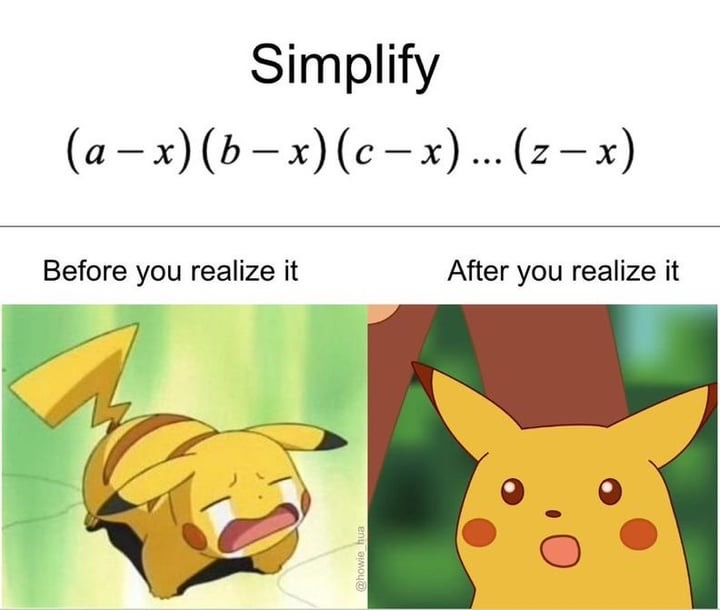this post was submitted on 23 Nov 2024
322 points (96.8% liked)
Math Memes
1156 readers
1 users here now
Memes related to mathematics.
Rules:
1: Memes must be related to mathematics in some way.
2: No bigotry of any kind.
founded 2 years ago
MODERATORS
you are viewing a single comment's thread
view the rest of the comments
view the rest of the comments

Ok, wtf. Why write it like this then?
To make sure what's inside the brackets is resolved internally before they're multiplied with each other.
TIL this notation makes it math the text up
Edit: hmm, already shows in a code block so adding backticks didn’t do anything
To expand on what superkret said, in math there is the concept of "order of operations". That is to say, every function in math (add, multiply, divide) has to be done in a specific order. Since multiplication comes before addition and subtraction, if you have a formula like a-x*b-x, you will do x*b first, then a minus the result of x*b, which would give a very different result than if you did a-x and multiplied that by b-x. This is where the parenthesis come in. You are basically saying, resolve every section in parenthesis first using the proper order, then resolve the rest.
My original example (a)(b) was over simplified, because there is no conflict there. You can also do things like (a*x)-(b*x). If there is no operator though, it is assumed multiplication, and I'm unsure why that is.
Putting multiple asterisks in a comment makes it look italicized, at least on some Lemmy clients. If you want to have asterisks with *unitalicized* text, you gotta put a \ behind the * to negate the change
Oops, I should have previewed it, thanks for pointing it out.
Actually it's (axb), since a(b+c)=(ab+ac). This is where a lot of people go wrong in the order of operations questions you see on socials - removing the brackets too soon. 1/ab=1/(axb) NOT 1/axb. If a=2 and b=3 then 1/ab=1/(2x3)=1/6, but 1/axb=1/2x3=3/2. Note that this also means it gets solved in the Brackets step of order of operations, NOT the "Multiplication" step (another common mistake).
It's not "multiplication", it's a Product, a single number written as a product of factors. If a=2 and b=3 then ab is 6 written as the product of 2 and 3. ab=(2)(3)=(2x3)=6. axb=ab, 2x3=6, axb=2x3, ab=6.
To show it's a single number, not 2 separate numbers to be multiplied. Think of things like F=ma. You have to show that ma is a single number (equal to the Force), not 2 separate numbers multiplied., mxa. If you were doing something like dividing by the Force, then you have to have 1/ma=1/(mxa), NOT 1/mxa.
Because you wrote a lot less when writing it this way. Groups of terms beside each other are multiplying each other and you have to solve what's inside of those groups before multiplying them together.
Actually the whole thing is a single Term. Terms are separated by operators and joined by grouping symbols, and there's no operators between the successive brackets.
You don't have to, but it sure makes the working-out a lot easier if you do!
If a=1, b=2, c=3, d=4, then...
(a+b)(c+d)=(ac+ad+bc+bd)
(1+2)(3+4)=(1x3+1x4+2x3+2x4)=(3+4+6+8)=21
whereas...
(1+2)(3+4)=(3)(7)=(3x7)=21 :-)